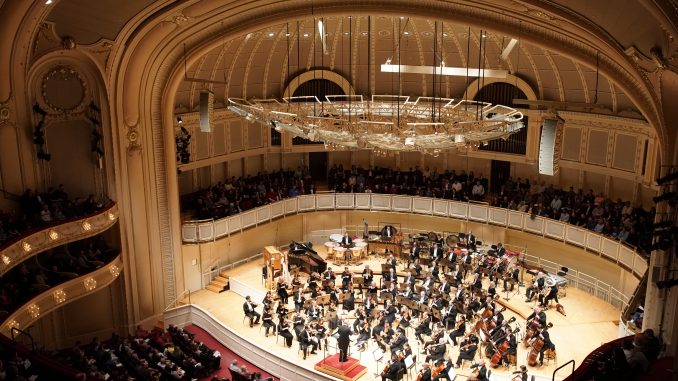
On May 31, 2018, in a program to be repeated June 1st, 2nd, and 3rd, celebrated Conductor Marek Janowski led the Chicago Symphony Orchestra in a concert of works by Weber, Beethoven and Wagner, at Symphony Center, 220 S. Michigan, Chicago. Appearing as guest principal horn this week is Luiz Garcia, principal horn of the Sao Paulo Symphony. Both the conductor, in his subscription series debut, and the Orchestra being great masters of music from the Austro-German tradition, they performed glorious orchestral excerpts from two of Wagner’s grandest operas,Tannhäuser and Die Meistersinger.Also on the program was Beethoven’s sunny Fourth Symphony, a work imbued with romantic pathos, and the Overture to Weber’s Euryanthe.
Janowski is a conductor with tremendous authority, strength and control. There was never a moment when he seemed less than absolutely certain, both mentally and corporeally, of the clear direction he provided for the Orchestra. The Chicago Symphony Orchestra was likewise in fine form, crisp, unerring, solid.

The program:
– Carl Maria von Weber Overture to Euryanthe, 1822-23
This composer is known for his originality, intellectualism, drama and intensity. The overture to the Opera Euryanthe is considered to be an outstanding example of the German Romantic style, still popular since it’s initial performance in 1823, although the opera itself has remained markedly less successful.
The Overture opens with the full complement of woodwinds pronouncing the opening theme, fully supported by the power of the Orchestra as a whole.
The second theme enters as a graceful melody with a colorful tutti leading to a Largo with muted violins and violas. Next, the basses intervene after a brief pause, introducing a provocative episode before a beautiful expansion of the first theme, a resounding return of the second theme and a vibrantly strong Coda closed the Overture.
– Ludwig van Beethoven Symphony No. 4 in B-flat Major, Op. 60, 1806
This is a deep and powerfully beautiful work, developing from a slow introduction, with “jabbing dissonances” before a stirring Allegro vivace, a veritable fountain of melody. The Adagio that follows is emotional yet sounding almost lazy. This movement is succeeded by an Allegro vivace that features elements of both a Scherzo and a Minuet; the trio section is played twice, creating a five-part structure. Finally, the Symphony concludes with a dazzling “perpetual motion” Allegro.
– Richard Wagner Overture and Venusberg Music from Tannhäuser
In 2014, Pentatone released a 32 disc recording, to great critical acclaim, of all 10 of Wagner’s operas conducted by Janowski; this was the first time any record company recorded all of the operas, including the Ring Cycle, “with the same musical forces”. The reviews included a comment about Tannhaüser from Lynn René Bayley, writing for FANFARE, who noted, “From the first note of the overture in this performance, one is aware of a superior musical mind at work, the mind of conductor Marek Janowski”.
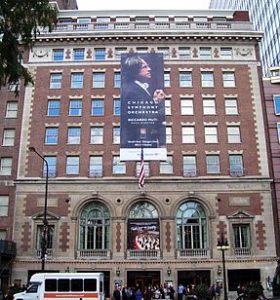
The performance heard at Symphony Center of the Overture and Venusberg Music was likewise cerebral, constant, well phrased and lively. The Chicago Symphony Orchestra sounded warm and picturesque in this masterpiece of the repertoire. There is an underlying mixture of spirituality and sensuality, the sacred with the profane, as the first chorale of winds is followed by the entrance of rhythmic strings, with an octave “skip” up and dual chromatic notes down herald the move from innocence to voluptuousness. The Orchestra was transparently clear, the brass in particular resounding in this symphonic poem.
– Richard Wagner Prelude to Act 3 of Die Meistersinger von Nürnberg, 1862-67
– Richard Wagner Prelude to Act 1 of Die Meistersinger von Nürnberg, 1862-67
These pieces were presented attacca, the percussion/timpani outdoing themselves in accentuating color. The presentation of the somber, thoughtful orchestral prelude to Act 3 was truly wonderful, reminiscent of a string quartet, gaining energy and good humour as it moved into the Act 1 prelude, producing a full, rich, deep sound from the Chicago Symphony Orchestra in this lushly textured score. The supremely confident conductor produced a sustained musical continuity with obvious concentration; the playing was beautiful.
For information and tickets to all the fine programming of the Chicago Symphony Orchestra, go to www.cso.org

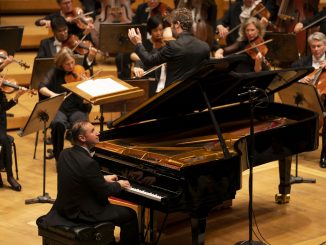
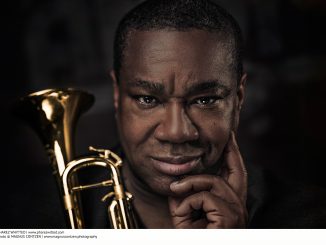
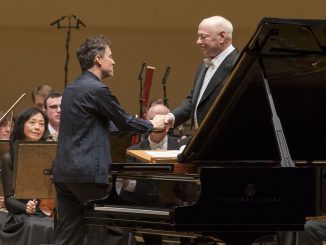
Be the first to comment